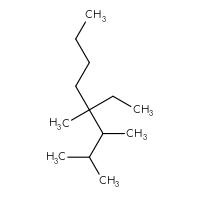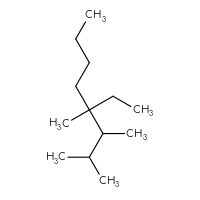
Chemistry 2012 Student Edition (hard Cover) Grade 11
12th Edition
ISBN: 9780132525763
Author: Prentice Hall
Publisher: Prentice Hall
expand_more
expand_more
format_list_bulleted
Question
Chapter 22.1, Problem 6SP
Interpretation Introduction
Interpretation: Structural formula for 4-ethyl-2,3,4-trimethyloctane is to be drawn.
Concept Introduction: Organic compounds containing single-bonded Carbon and Hydrogen atoms are
Formula for Alkane is CnH2n+2
Expert Solution & Answer
Answer to Problem 6SP
Structural formula for 4-ethyl-2,3,4-trimethyloctane is

Explanation of Solution
Given Information: 4-ethyl-2,3,4-trimethyloctane has a structural formula.
The compound contains 8 carbon atoms as it has “Oct” in the name. For “ane” the compound contains a single bond. For “4-ethyl” the compound contains Ethyl group (-CH2-CH3) on the 4-Carbon atom. For “2,3,4-trimethyl” the compound contains Methyl group (-CH3) on the 2,3,4- Carbon atoms.
Conclusion
Structural formula for 4-ethyl-2,3,4-trimethyloctane is

Chapter 22 Solutions
Chemistry 2012 Student Edition (hard Cover) Grade 11
Ch. 22.1 - Prob. 1SPCh. 22.1 - Prob. 2SPCh. 22.1 - Prob. 3SPCh. 22.1 - Prob. 4SPCh. 22.1 - Prob. 5SPCh. 22.1 - Prob. 6SPCh. 22.1 - Prob. 7LCCh. 22.1 - Prob. 8LCCh. 22.1 - Prob. 9LCCh. 22.1 - Prob. 10LC
Ch. 22.1 - Prob. 11LCCh. 22.1 - Prob. 12LCCh. 22.1 - Prob. 13LCCh. 22.2 - Prob. 14LCCh. 22.2 - Prob. 15LCCh. 22.2 - Prob. 16LCCh. 22.2 - Prob. 17LCCh. 22.2 - Prob. 18LCCh. 22.3 - Prob. 19SPCh. 22.3 - Prob. 20SPCh. 22.3 - Prob. 21LCCh. 22.3 - Prob. 22LCCh. 22.3 - Prob. 23LCCh. 22.3 - Prob. 24LCCh. 22.3 - Prob. 25LCCh. 22.3 - Prob. 26LCCh. 22.3 - Prob. 27LCCh. 22.4 - Prob. 28LCCh. 22.4 - Prob. 29LCCh. 22.4 - Prob. 30LCCh. 22.4 - Prob. 31LCCh. 22.4 - Prob. 32LCCh. 22.5 - Prob. 33LCCh. 22.5 - Prob. 34LCCh. 22.5 - Prob. 35LCCh. 22.5 - Prob. 36LCCh. 22.5 - Prob. 37LCCh. 22.5 - Prob. 38LCCh. 22.5 - Prob. 39LCCh. 22.5 - Prob. 40LCCh. 22 - Prob. 41ACh. 22 - Prob. 42ACh. 22 - Prob. 43ACh. 22 - Prob. 44ACh. 22 - Prob. 45ACh. 22 - Prob. 46ACh. 22 - Prob. 47ACh. 22 - Prob. 48ACh. 22 - Prob. 49ACh. 22 - Prob. 50ACh. 22 - Prob. 51ACh. 22 - Prob. 52ACh. 22 - Prob. 53ACh. 22 - Prob. 54ACh. 22 - Prob. 55ACh. 22 - Prob. 56ACh. 22 - Prob. 57ACh. 22 - Prob. 58ACh. 22 - Prob. 59ACh. 22 - Prob. 60ACh. 22 - Prob. 61ACh. 22 - Prob. 62ACh. 22 - Prob. 63ACh. 22 - Prob. 64ACh. 22 - Prob. 65ACh. 22 - Prob. 66ACh. 22 - Prob. 67ACh. 22 - Prob. 68ACh. 22 - Prob. 69ACh. 22 - Prob. 70ACh. 22 - Prob. 71ACh. 22 - Prob. 72ACh. 22 - Prob. 73ACh. 22 - Prob. 74ACh. 22 - Prob. 75ACh. 22 - Prob. 76ACh. 22 - Prob. 77ACh. 22 - Prob. 78ACh. 22 - Prob. 79ACh. 22 - Prob. 80ACh. 22 - Prob. 81ACh. 22 - Prob. 82ACh. 22 - Prob. 84ACh. 22 - Prob. 85ACh. 22 - Prob. 86ACh. 22 - Prob. 87ACh. 22 - Prob. 89ACh. 22 - Prob. 90ACh. 22 - Prob. 91ACh. 22 - Prob. 92ACh. 22 - Prob. 93ACh. 22 - Prob. 94ACh. 22 - Prob. 95ACh. 22 - Prob. 96ACh. 22 - Prob. 97ACh. 22 - Prob. 98ACh. 22 - Prob. 99ACh. 22 - Prob. 100ACh. 22 - Prob. 101ACh. 22 - Prob. 102ACh. 22 - Prob. 103ACh. 22 - Prob. 104ACh. 22 - Prob. 105ACh. 22 - Prob. 106ACh. 22 - Prob. 107ACh. 22 - Prob. 108ACh. 22 - Prob. 109ACh. 22 - Prob. 110ACh. 22 - Prob. 111ACh. 22 - Prob. 1STPCh. 22 - Prob. 2STPCh. 22 - Prob. 3STPCh. 22 - Prob. 4STPCh. 22 - Prob. 5STPCh. 22 - Prob. 6STPCh. 22 - Prob. 7STPCh. 22 - Prob. 8STPCh. 22 - Prob. 9STPCh. 22 - Prob. 10STPCh. 22 - Prob. 11STPCh. 22 - Prob. 12STPCh. 22 - Prob. 13STPCh. 22 - Prob. 14STPCh. 22 - Prob. 15STPCh. 22 - Prob. 16STP
Knowledge Booster
Similar questions
- Predict the products of this organic reaction: + H ZH NaBH3CN H+ n. ? Click and drag to start drawing a structure. Xarrow_forwardWhat is the missing reactant R in this organic reaction? + R H3O+ + • Draw the structure of R in the drawing area below. • Be sure to use wedge and dash bonds if it's necessary to draw one particular enantiomer. Click and drag to start drawing a structure.arrow_forwardWhat would be the best choices for the missing reagents 1 and 3 in this synthesis? 1 1. PPh3 2. n-BuLi 2 • Draw the missing reagents in the drawing area below. You can draw them in any arrangement you like. • Do not draw the missing reagent 2. If you draw 1 correctly, we'll know what it is. • Note: if one of your reagents needs to contain a halogen, use bromine. Click and drag to start drawing a structure.arrow_forward
- The product on the right-hand side of this reaction can be prepared from two organic reactants, under the conditions shown above and below the arrow. Draw 1 and 2 below, in any arrangement you like. 1+2 NaBH₂CN H+ N Click and drag to start drawing a structure. X $arrow_forwardExplain what is the maximum absorbance of in which caffeine absorbs?arrow_forwardExplain reasons as to why the amount of caffeine extracted from both a singular extraction (5ml Mountain Dew) and a multiple extraction (2 x 5.0ml Mountain Dew) were severely high when compared to coca-cola?arrow_forward
- Protecting Groups and Carbonyls 6) The synthesis generates allethrolone that exhibits high insect toxicity but low mammalian toxicity. They are used in pet shampoo, human lice shampoo, and industrial sprays for insects and mosquitos. Propose detailed mechanistic steps to generate the allethrolone label the different types of reagents (Grignard, acid/base protonation, acid/base deprotonation, reduction, oxidation, witting, aldol condensation, Robinson annulation, etc.) III + VI HS HS H+ CH,CH,Li III I II IV CI + P(Ph)3 V ༼ Hint: no strong base added VI S VII IX HO VIII -MgBr HgCl2,HgO HO. isomerization aqeuous solution H,SO, ༽༽༤༽༽ X MeOH Hint: enhances selectivity for reaction at the S X ☑arrow_forwardDraw the complete mechanism for the acid-catalyzed hydration of this alkene. esc 田 Explanation Check 1 888 Q A slock Add/Remove step Q F4 F5 F6 A བྲA F7 $ % 5 @ 4 2 3 & 6 87 Click and drag to start drawing a structure. © 2025 McGraw Hill LLC. All Rights Reserved. Terms of Use | Privacy Ce W E R T Y U S D LL G H IK DD 요 F8 F9 F10 F1 * ( 8 9 0 O P J K L Z X C V B N M H He commandarrow_forwardExplanation Check F1 H₂O H₂ Pd 1) MCPBA 2) H3O+ 1) Hg(OAc)2, H₂O 2) NaBH4 OH CI OH OH OH hydration halohydrin formation addition halogenation hydrogenation inhalation hydrogenation hydration ☐ halohydrin formation addition halogenation formation chelation hydrogenation halohydrin formation substitution hydration halogenation addition Ohalohydrin formation subtraction halogenation addition hydrogenation hydration F2 80 F3 σ F4 F5 F6 1 ! 2 # 3 $ 4 % 05 Q W & Å © 2025 McGraw Hill LLC. All Rights Reserved. F7 F8 ( 6 7 8 9 LU E R T Y U A F9arrow_forward
- Show the mechanism steps to obtain the lowerenergy intermediate: *see imagearrow_forwardSoap is made by the previous reaction *see image. The main difference between one soap and another soap isthe length (number of carbons) of the carboxylic acid. However, if a soap irritates your skin, they mostlikely used too much lye.Detergents have the same chemical structure as soaps except for the functional group. Detergentshave sulfate (R-SO4H) and phosphate (R-PO4H2) functional groups. Draw the above carboxylic acidcarbon chain but as the two variants of detergents. *see imagearrow_forwardWhat are the reactions or reagents used? *see imagearrow_forward
arrow_back_ios
SEE MORE QUESTIONS
arrow_forward_ios
Recommended textbooks for you
 ChemistryChemistryISBN:9781305957404Author:Steven S. Zumdahl, Susan A. Zumdahl, Donald J. DeCostePublisher:Cengage Learning
ChemistryChemistryISBN:9781305957404Author:Steven S. Zumdahl, Susan A. Zumdahl, Donald J. DeCostePublisher:Cengage Learning ChemistryChemistryISBN:9781259911156Author:Raymond Chang Dr., Jason Overby ProfessorPublisher:McGraw-Hill Education
ChemistryChemistryISBN:9781259911156Author:Raymond Chang Dr., Jason Overby ProfessorPublisher:McGraw-Hill Education Principles of Instrumental AnalysisChemistryISBN:9781305577213Author:Douglas A. Skoog, F. James Holler, Stanley R. CrouchPublisher:Cengage Learning
Principles of Instrumental AnalysisChemistryISBN:9781305577213Author:Douglas A. Skoog, F. James Holler, Stanley R. CrouchPublisher:Cengage Learning Organic ChemistryChemistryISBN:9780078021558Author:Janice Gorzynski Smith Dr.Publisher:McGraw-Hill Education
Organic ChemistryChemistryISBN:9780078021558Author:Janice Gorzynski Smith Dr.Publisher:McGraw-Hill Education Chemistry: Principles and ReactionsChemistryISBN:9781305079373Author:William L. Masterton, Cecile N. HurleyPublisher:Cengage Learning
Chemistry: Principles and ReactionsChemistryISBN:9781305079373Author:William L. Masterton, Cecile N. HurleyPublisher:Cengage Learning Elementary Principles of Chemical Processes, Bind...ChemistryISBN:9781118431221Author:Richard M. Felder, Ronald W. Rousseau, Lisa G. BullardPublisher:WILEY
Elementary Principles of Chemical Processes, Bind...ChemistryISBN:9781118431221Author:Richard M. Felder, Ronald W. Rousseau, Lisa G. BullardPublisher:WILEY

Chemistry
Chemistry
ISBN:9781305957404
Author:Steven S. Zumdahl, Susan A. Zumdahl, Donald J. DeCoste
Publisher:Cengage Learning

Chemistry
Chemistry
ISBN:9781259911156
Author:Raymond Chang Dr., Jason Overby Professor
Publisher:McGraw-Hill Education

Principles of Instrumental Analysis
Chemistry
ISBN:9781305577213
Author:Douglas A. Skoog, F. James Holler, Stanley R. Crouch
Publisher:Cengage Learning

Organic Chemistry
Chemistry
ISBN:9780078021558
Author:Janice Gorzynski Smith Dr.
Publisher:McGraw-Hill Education

Chemistry: Principles and Reactions
Chemistry
ISBN:9781305079373
Author:William L. Masterton, Cecile N. Hurley
Publisher:Cengage Learning

Elementary Principles of Chemical Processes, Bind...
Chemistry
ISBN:9781118431221
Author:Richard M. Felder, Ronald W. Rousseau, Lisa G. Bullard
Publisher:WILEY